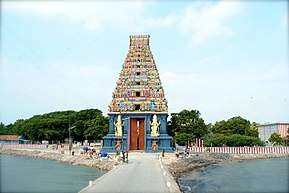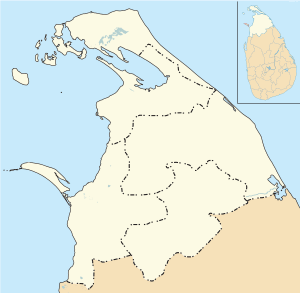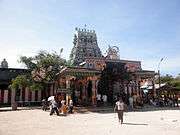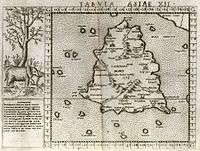Nainativu
| Nainativu நயினாதீவு නාගදීපය | |
|---|---|
| Island | |
 Nagapooshani Amman Kovil | |
 Nainativu | |
| Coordinates: 9°36′0″N 79°46′0″E / 9.60000°N 79.76667°ECoordinates: 9°36′0″N 79°46′0″E / 9.60000°N 79.76667°E | |
| Country | Sri Lanka |
| Province | Northern |
| District | Jaffna |
| DS Division | Island South |
Nainativu (Tamil: நயினாதீவு Nainatheevu, Sinhalese: නාගදීපය Nagadeepa), is a small but notable island off the coast of Jaffna Peninsula in the Northern Province, Sri Lanka. The name of the island alludes to the folklore inhabitants, the Naga people. It is home to the Hindu shrine of Nagapooshani Amman Temple; one of the prominent 64 Shakti Peethas, and the Buddhist shrine Nagadeepa Purana Viharaya.
Historians note the island is mentioned in the ancient Tamil Sangam literature of nearby Tamil Nadu such as Manimekalai where it was mentioned as Manipallavam (Tamil: மணிபல்லவம்), and ancient Buddhist legends of Sri Lanka such as Mahavamsa. Ptolemy, a Greek cartographer, describes the Tamil territory including islands around the Jaffna peninsula as Nagadibois in the first century CE.[1]
History
Nāka Tivu / Nāka Nadu was the name of the whole Jaffna peninsula in some historical documents. There are number of Buddhist myths associated with the interactions of people of this historical place with Buddha.[2] The two Tamil Jain and Buddhist epics of the second century - Kundalakesi and Manimekalai - describe the islet of Manipallavam of Nāka Nadu, this islet of the Jaffna peninsula, from where merchants came to obtain gems and conch shells.[3] The protagonists of the former story by Ilango Adigal visited the island. In the latter poem by Sīthalai Sāttanār, the sea goddess Manimekhala brings the heroine to the island, where she worships Lord Buddha. She is also told of the petrosomatoglyph atop the mountain of the main island and a magic bowl Amudha Surabhi (cornucopia bowl) that appears once every year in a lake of the islet.
The Manimekhalai and the Mahavamsa both describe Buddha settling a dispute between two Naga princes over a gem set throne seat on an island known as Manipallavam or Nagadeepa, identified as Nainativu by several scholars.[4] The Tamil language inscription of the Nainativu Hindu temple by Parâkramabâhu I of the 12th century CE states that foreigners landing at new ports must meet at Kayts and they must be protected, and if ships to the islet carrying elephants and horses get shipwrecked, a fourth of the cargo must go to the treasury.[5]
Naga People
Naga people were snake-worshippers, a Dravidian custom, and spoke Tamil based on Ptolemy's description of the Naga people.[6][7] They also likely spoke Prakrit, a language of the school of Amaravathi village, Guntur district with which the early Tamils of Jaffna had strong cultural relations during the classical period. The Nākas were a branch of the Dravidian community, and were at that time part of the Chera kingdom, and of ancient Tamilakam. A rchaeological excavations and studies provide evidence of palaeolithic inhabitation in the Tamil dominated Northern and Eastern Sri Lanka and in Tamil Naadu and Chera Naadu (Kerala region). The findings include Nāka idols and suggest that serpent worship was widely practised in the Dravidian regions of India and Sri Lanka during the megalithic period.[8][9][10][11][12]
The Nākas lived among the Yakkha, Raksha and Deva in Ceylon according to the Manimekalai and Mahavamsa. Cobra worship, Tamil speech and Keralan cuisine extant in Jaffna Tamil culture from the classical period attests to the Nāka's heritage.
Sangam literature details how the ancient Tamil people were divided into five clans (Kudi) based on their profession during the Sangam period, where the Nāka clan, who were in charge of border security guarding the city wall and distant fortresses, inhabited the Coromandel Coast - South Tamil Nadu, East Tamil Nadu and North Sri Lanka. The name Nāka was either a corrupted version of the word Nayinaar or may have been applied to this community due to their head covering being the shape of a hydra-headed cobra in reverence to their serpentine deities. British historian and author of "Ancient Ceylon" considers the Nāka to be an offshoot of the Nayars of Kerala[13] Ancient Tamil epic Manimekalai and the Sri Lankan history book Mahavamsa both mention a dispute between two Naga kings in northern Sri Lanka.[14] Some scholars derives the origin of the Pallava dynasty of Tamilakam from an marriage alliance of the Cholas and the Naga from Jaffna Peninsula.[15] This incident is mentioned in the Tamil epic, Manimekalai. [16]
Decline of Naga identity and assimilation
According to scholars did the Naga people, also known as Nayanair, assimilate to Tamil language and culture, forming one of descendants of the Sri Lankan Tamils.[17][18] They continue to worship their patron Nayinaar deity (a five headed cobra) and Nagapooshani Amman even today within the sanctum sanctorum of the Nainativu Nagapooshani Amman Temple.[19]
Demography
The population of the island is approximately 2,500 Sri Lankan Tamils and about 150 Muslims. Many Tamils of Nainativu origin, live in various cities and towns of India, Europe, Australia, and North America as part of the Sri Lankan Tamil diaspora.[20]
Gallery


See also
| Wikimedia Commons has media related to Nainativu. |
References
- ↑ Rajeswaran, S. T. B. (2012). Geographical Aspects of the Northern Province, Sri Lanka. University of Jaffna: Governor's Office, Department of Geography. p. 61.
- ↑ Malalasekera, G.P. (2003). Dictionary of Pali Proper Names: Pali-English. Asian Educational Services. p. 42. ISBN 81-206-1823-8.
- ↑ Journal of Indian History. University of Allahabad: Department of Modern Indian History. 1965. p. 18.
- ↑ Malalasekera, Gunapala Piyasena (1961). Encyclopaedia of Buddhism. Government of Ceylon. p. 83.
- ↑ K. Indrapala. (1963). The Nainativu Tamil Inscription of Parakramabahu I. UCR Vol XX1. No. 1. pp.70
- ↑ Laura Smid (2003). South Asian folklore: an encyclopedia : Afghanistan, Bangladesh, India, Pakistan, Sri Lanka. Great Britain: Routledge. 429.
- ↑ Chelvadurai Manogaran (1987). Ethnic conflict and reconciliation in Sri Lanka . United States of America: University of Hawaii Press. 21.
- ↑ http://keraladotpark.com/pdf/Archacological%20wonders.pdf A research paper from archaeologist Dr. P. Rajendran showing evidence of paleolithic age human inhabitation in Kerala. This includes the pictures of serpent idols made of clay and metal which belong to the mesolithic age.
- ↑ Department of Archaeology, Kerala University confirms paleolithic age findings in Kerala
- ↑ General article for palaeolithic age findings in ancient Chera region
- ↑ A very detailed article including palaeolithic age in Kerala which was then part of Chera Naadu, one of the three Tamil kingdoms of that era
- ↑ "Anthropological museum to have new additions". The Hindu Newspaper (Kerala). 27 December 2010. Retrieved 2011-05-03.
- ↑ H. Parker (1909). Ancient Ceylon. New Dehli: Asian Educational Services. 7.
- ↑ http://www.lankalibrary.com/heritage/naga.htm
- ↑ A Comprehensive History Of Ancient India (3 Vol. Set). Sterling Publishers Pvt. Ltd. 2003-12-01. p. 184. ISBN 9788120725034.
- ↑ Tripathi, Alok; India, Archaeological Survey of; Navy, India Indian (2007-09-01). India and the eastern seas. Organising Committee of International Seminar on Marine Archaeology. p. 51. ISBN 9788173200755.
- ↑ Holt, John (2011-04-13). The Sri Lanka Reader: History, Culture, Politics. Duke University Press. p. 74. ISBN 0822349825.
- ↑ Rajeswaran, S. T. B. (2012). Geographical Aspects of the Northern Province, Sri Lanka. University of Jaffna: Governor's Office, Department of Geography. p. 60.
- ↑ XV Governors' Conference: Northern Province at Tilko Jaffna City Hotel 15.11.2012 (in Tamil). Northern Province, Government of Sri Lanka. 2012. p. 22.
- ↑ Meeadhu, Kalabooshanam (13 June 2008). "Nainativu Nagapooshani Chariot festival". Archived from the original on 4 June 2011. Retrieved 18 January 2011.


